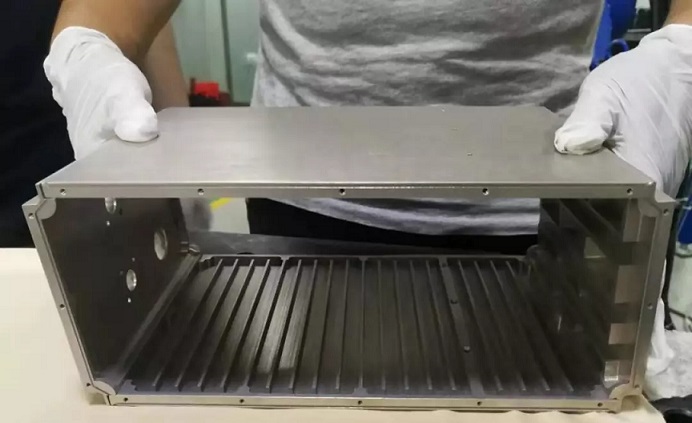At 0:53 on December 25, 2018, China used the Long March 3C carrier rocket at the Xichang Satellite Launch Center to successfully launch the communication technology test satellite No. 3, and the satellite entered a predetermined orbit.
It is worth noting that this "Communication Technology Test Satellite No. 3" uses the magnesium-lithium alloy materials LA103Z and LA43M independently developed by China in the parts such as embedded parts, brackets and some chassis cases.
Magnesium-lithium alloy is the lightest metal material in the world today. It has ultra-low density, ultra-high elongation, good electrical and thermal conductivity, excellent electromagnetic shielding performance, outstanding seismic and noise reduction performance, and molding processing performance analogous to aluminum alloy. The forefront of the development of magnesium alloy technology is called the most "green and environmentally friendly" revolutionary metal material in the future.
With the rapid development of the global defense technology industry, countries have been vigorously developing high-performance lightweight structural materials, reducing weight on rockets, missiles, satellites, fighters, etc. The "sensitivity" to weight is almost "era. There is a mantra in the industry: "Saving a gram of satellite weight is equivalent to saving one gram of gold!"
It is against this background that in September 2009, the technical team of XASF Ultralight Alloy Material Technology Company and the metal materials research team of Xi’an Jiaotong University established the first magnesium-lithium alloy with independent intellectual property rights in China production line.
Since then, China-made magnesium-lithium alloy has started a journey of overtaking with the international giants.
In early 2014, XASF Ultralight Alloy Material Technology Co., Ltd. participated in the formulation of the national standard for magnesium-lithium alloys. It took three years to finally formulate China ’s first magnesium-lithium alloy national standard-"magnesium-lithium alloy ingot", which filled The industry gap in the field of magnesium-lithium alloys.
Magnesium-lithium alloy sheet
In April of the same year, it passed the review of the Eighth Aerospace Academy and became a qualified supplier, marking that XASF's magnesium-lithium alloy material has officially moved from the scientific research and testing stage to the large-scale production stage, which can play an important role in China's aerospace field.
On September 25, 2015, China successfully launched the "Pujiang-1" satellite. The outstanding feature of this satellite in terms of materials is the first application of the magnesium-lithium alloy independently developed and produced by China.
On December 22, 2016, China successfully launched the first high-resolution micro-nano satellite in the global carbon dioxide monitoring scientific experimental satellite. The satellite used this new type of magnesium-lithium alloy material to replace aluminum alloy structural materials almost all.
Coupled with the communication technology test satellite No. 3 launched in 2018, these satellites use the magnesium-lithium alloy produced by XASF. Its density is 20% to 30% lighter than conventional magnesium alloys and 40% to 50% lighter than aluminum alloys. Therefore, it plays an important role in reducing the structural quality of the system and increasing the payload of the satellite, which is the success of the satellite. Ascension and traveling to space made great contributions.
Due to confidentiality reasons, other application examples cannot be listed here.
For this moment, XASF and the R & D team of Xi'an Jiaotong University struggled for ten years.
XASF has achieved breakthrough results in smelting process, quality control, surface treatment, mechanical processing, etc., with an annual output of 1,000 tons and an output value of hundreds of millions of yuan.
XASF has three brands of ultra-light magnesium-lithium alloys with independent intellectual property rights-the overall technology of the LA43M, LA103M and LA103Z series is at the leading domestic and international advanced level. Tens of Mp higher than their tensile strength. "
With today's increasing demands on structural materials for light weight, weight reduction, energy saving, environmental protection and sustainable development, magnesium-lithium alloys also show broad application prospects in transportation, electronics, medical products and other fields that require lightweight structural materials.
Taking electronic products as an example, in recent years, thin and light books have become the main products of major notebook manufacturers in recent years. In addition to the thinner and thinner notebooks, in addition to the thickness control of internal components, the volume and integration of components, the choice of notebook shell materials is also the main way to reduce the weight of notebooks. Magnesium aluminum alloy and carbon fiber composite materials.
Nowadays, the new material magnesium-lithium alloy comes into the sky, and there are new options for weight reduction of laptops. Magnesium-lithium alloy is the lightest commercial alloy with a density of only 1.48 grams / cubic centimeter, while the density of aluminum alloy is 2.80 grams / cubic centimeter. Magnesium-lithium alloy is almost equal to half the weight of aluminum alloy. As for another feature of magnesium-lithium alloys, good heat dissipation, and the continuous increase in power consumption of electronic products, heat dissipation will be an important key.
Magnesium lithium alloy heat sink
In November 2018, Fujitsu released the latest "LIFEBOOK UH Series" notebook in Japan. Compared with the first half of 2018, the lightest models of the new UH series of notebooks unveiled this time have lost weight again. Among them, the UH-X C3 weighs only 698g, which is the lightest in the world among the 13.3-inch models. The magnesium-lithium alloy material used.
With the trend of ultra-thin, ultra-light and miniaturization in the consumer electronics market, the market size of magnesium-lithium alloys and their composite materials is huge.
Magnesium lithium alloy chassis
On July 6, 2019, XATZ New Materials Group and XASF Ultralight Alloy Material Technology Co., Ltd. held a cooperation signing ceremony. The two parties will start a strategic cooperation on the development and production of ultralight magnesium-lithium alloy technology, and plan to make magnesium-lithium The annual output of alloy can reach more than 3000 tons.


